EasyShare DX7590: Kodak's Second Ultra-Zoom Digicam
by Stephen Caston on February 11, 2005 12:03 AM EST- Posted in
- Digital Camera
The Design: Kodak DX7590
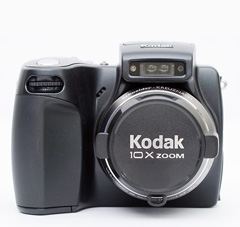 |
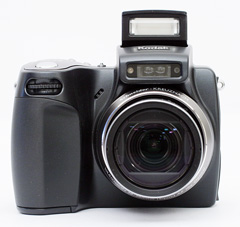 |
| Click images to enlarge. | |
The front of the DX7590 features a powerful Schneider-Kreuznach 10x optical zoom lens with a 35mm equivalent zoom range of 38 - 380mm. The lens is protected by a removable lens cap that can be tethered to the camera body via the included cord. The lens is threaded and accepts a number of accessory filters and lenses. However, to use the lens accessories, you must first get a lens adaptor for around $20. Directly above the lens are the self-timer/video light and the hybrid AF (passive sensor). The hybrid AF sensor allows the camera to focus faster and in low light conditions. Directly above this is the built-in popup flash with a working range of 2 - 16.1' at wide angle and 6.6 - 12.1' at telephoto (using Auto ISO). The flash in this camera is considerably more powerful than average. On the left side of the front is a large handgrip with a groove for your fingers. In the dip between the handgrip and the lens is the built-in microphone. On the upper part of the handgrip is the "Jog dial", which can be pushed in as well as rotated left and right. This dial is used to set exposure compensation as well as advanced exposure settings.
The first thing to notice on the back is the roomy 2.2" LCD monitor with 153,000 pixels. Directly above the LCD monitor is the EVF (electronic viewfinder) with a high resolution of 311,000 pixels. To the left of the EVF is the EVF/LCD toggle button, which is used to switch between the LCD monitor and the EVF. A diopter adjustment knob can be found on the left side of the viewfinder as well. On the opposite side at the top are the main power button and the zoom controller. The zoom controller is very responsive and has two speeds depending on how far it is pushed in each direction. Just below the zoom controller are 5 small bumps designed to help make the camera easier to grip with your thumb. Below this is the Mode Dial, which can be rotated to select the desired shooting mode. In the center of the Mode Dial is a multi-directional joystick. The joystick can also be pushed in to select menu items and settings. When the camera is on and the lens is extended, the area surrounding the joystick illuminates with a greenish yellow light. This light turns red in Favorites mode. Directly above the Mode Dial are the Status and Share buttons. Under the Mode Dial are three more buttons: Delete, Menu, and Review.
On top of the camera is the built-in flash, which pushes down into the camera body. To open the flash, you must slide the flash release button to the right. Just below the flash release button are three main function buttons: Flash, Close-up/Landscape, and Exposure bracketing/First burst/Last burst. To the right of these buttons is the speaker. Finally, at the upper-right is the shutter release button.
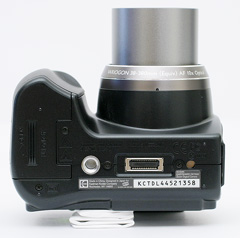 |
 |
| Click images to enlarge. | |
The bottom of the camera features a sliding hinged door that hides the battery compartment. The door has a sturdy feel to it unlike many cameras that we have tested before. The camera uses the supplied KLIC-5001 rechargeable lithium-ion battery 3.7V 1700mAh. Immediately to the right of the battery compartment is a metal tripod mount. Finally, below the lens is the connector for the EasyShare dock, which lets you charge the battery, print images, and transfer media to your computer.
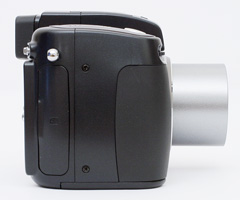 |
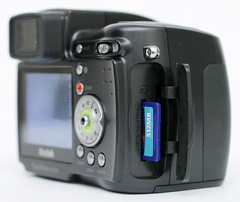 |
| Click images to enlarge. | |
The right side of the camera features a hinged door that covers the SD/MMC flash card slot. The DX7590 does not come with a flash card, but the camera has 32 MB of internal memory. We highly recommend starting out with a 128 MB or larger SD card. Also on this side is a post for the included neck strap.
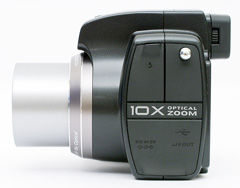 |
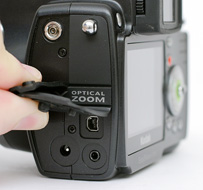 |
| Click images to enlarge. | |
On the left side of the camera are two rubber flaps that snap in place to conceal multiple connections. The top left flap hides the external flash connector. The bottom flap covers a DC-in port for the AC adaptor, a USB port, and an A/V-out connector. The external flash connector has a 500 volt maximum.


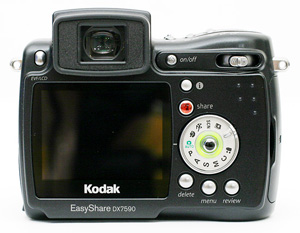









10 Comments
View All Comments
Locut0s - Saturday, February 12, 2005 - link
I could be wrong but isn't Kodak well known for making relatively low quality consumer and prosumer digital cameras while making really good top of the line digital cameras? By top of the line I mean REALLY top of the line.bpt8056 - Saturday, February 12, 2005 - link
I have been looking at both the Panasonic FZ20 and the Kodak DX7590. I just spoke with the VP of Digital and Film Imaging from Kodak the other day and she basically said that the DX7590 is considered a "prosumer" type of camera, but with simplicity in mind. There's the keyword: simplicity. I like to take good quality pictures and I know the FZ20 is the one to get. However, my wife does all the organizing and printing since she's a consultant from Creative Memories. She wants the process of organizing, printing, ordering, etc. as easy as possible which the Kodak cameras can help her with. Even after repeatedly showing her the procedure with our current camera, she still needs my help and I tend to be busy doing something else.Here's my take on the DX7590 and the FZ20:
FZ20:
Pros
+ High resolution, sharp details
+ Image stabilization
+ Hotshoe
+ TIFF Mode
+ High Zoom (12x)
+ Colors are good, but shows a hint of yellow
+ Chromatic aberration almost nonexistant
Cons
- Poor low-light/indoor shots (external flash can fix this)
- Noise level is nasty above ISO 100 (hence indoor pics won't look too sharp)
- Not quite as compact as DX7590
- Simplicity??
DX7590:
Pros
+ Kodak Color science
+ White balance (the best I've seen)
+ High Zoom (10x)
+ Noise level is pretty good
+ Can be configured as point-and-shoot
+ EasyShare (simplicity)
+ External flash can be used (need to have bracket)
Cons
- Aggressive compression
- Soft details (grass looks muddy)
- Chromatic aberration is apparent
- No image stalization
- No TIFF or RAW mode
The FZ20 will give better results with pictures, but the DX7590 provides a better ease of use.
defter - Saturday, February 12, 2005 - link
Don't forget Panasonic FZ3: small size and 12x zoom with image stabilizer at ~$320.BPB - Friday, February 11, 2005 - link
The Panasonic reviews are impressive. Interesting that it too has slow frame rates for video with sound.One big plus, to my way of thinking, is the Kodak printer dock. We have one and love it, even though the price per print isn't that cheap. Still, it's a lot easier than heading out to a store or emailing to an eshop.
Wesley Fink - Friday, February 11, 2005 - link
#5 - If you are running the native and highest 1600x1200 resulution on your Dell, you are still compressing your image from 2576x1716 to 1600x1200 when you view it. Your Dell screen is less than 2 megapixels, so filling the screen is not any great indication of the quality of a 5 megapixel image. You would likely be better judging quality by viewing actual pixels on screen and scrolling around the image.ironman67 - Friday, February 11, 2005 - link
I've had a Lumix DMC-FZ20 for over a month--Fantastic!!! Pictures taken at medium quality at sharp and detailed even when I enlarge them to fill my 20 in. Dell LCD.BPB - Friday, February 11, 2005 - link
As a DX6490 owner, I think I'd be very happy with this camera. We may sell the 6490 and upgrade. Not being a bigtime photographer, the problems they mention here wouldn't matter much. The few annoyances the 6490 has for us seemed to have been bettered in this model. So, as an average camera schmuck, I think this would be a good camera.But I am going to look into the Lumix mentioned above.
plk21 - Friday, February 11, 2005 - link
I bought my mom the DX6490 (the 4MP version) for Christmas 2003, and it's a GREAT digicam. I'm thinking of getting this one for myself.The Doc is a nice feature for technophobes like my mother, with simple instructions like "Put the camera on the doc, and press the big button". That's one reason I reccomend Kodak cameras to less tech savy people. combined with Picasa2, they're absolutely perfect for those types of people. I get a lot less "support calls" for the Kodaks than other digicams.
Souka - Friday, February 11, 2005 - link
Agree....Also...yet another Kodak review on AT...ugh.... :(
fass mut - Friday, February 11, 2005 - link
for $500 clams..i'd go for the Lumix DMC-FZ20, 12X image stabilized!